Matplotlib = ease of use, Gnuplot = (slightly better) performance
I know this post is old and answered but I was passing by and wanted to put my two cents. Here is my conclusion: if you have a not-so-big data set, you should use Matplotlib. It's easier and looks better. However, if you really need performance, you could use Gnuplot. I've added some code to test it out on your machine and see for yourself if it makes a real difference (this is not a real performance benchmark but should give a first idea).
The following graph represents the required time (in seconds) to:
- Plot a random scatter graph
- Save the graph to a png file

Configuration:
- gnuplot: 5.2.2
- gnuplot-py: 1.8
- matplotlib: 2.1.2
I remember the performance gap being much wider when running on an older computer with older versions of the libraries (~30 seconds difference for a large scatter plot).
Moreover, as mentionned in the comments, you can get equivalent quality of plots. But you will have to put more sweat into that to do it with Gnuplot.
Here's the code to generate the graph if you want to give it a try on your machine:
# -*- coding: utf-8 -*-
from timeit import default_timer as timer
import matplotlib.pyplot as plt
import Gnuplot, Gnuplot.funcutils
import numpy as np
import sys
import os
def mPlotAndSave(x, y):
plt.scatter(x, y)
plt.savefig('mtmp.png')
plt.clf()
def gPlotAndSave(data, g):
g("set output 'gtmp.png'")
g.plot(data)
g("clear")
def cleanup():
try:
os.remove('gtmp.png')
except OSError:
pass
try:
os.remove('mtmp.png')
except OSError:
pass
begin = 2
end = 500000
step = 10000
numberOfPoints = range(begin, end, step)
n = len(numberOfPoints)
gnuplotTime = []
matplotlibTime = []
progressBarWidth = 30
# Init Gnuplot
g = Gnuplot.Gnuplot()
g("set terminal png size 640,480")
# Init matplotlib to avoid a peak in the beginning
plt.clf()
for idx, val in enumerate(numberOfPoints):
# Print a nice progress bar (crucial)
sys.stdout.write('\r')
progress = (idx+1)*progressBarWidth/n
bar = "▕" + "▇"*progress + "▁"*(progressBarWidth-progress) + "▏" + str(idx) + "/" + str(n-1)
sys.stdout.write(bar)
sys.stdout.flush()
# Generate random data
x = np.random.randint(sys.maxint, size=val)
y = np.random.randint(sys.maxint, size=val)
gdata = zip(x,y)
# Generate string call to a matplotlib plot and save, call it and save execution time
start = timer()
mPlotAndSave(x, y)
end = timer()
matplotlibTime.append(end - start)
# Generate string call to a gnuplot plot and save, call it and save execution time
start = timer()
gPlotAndSave(gdata, g)
end = timer()
gnuplotTime.append(end - start)
# Clean up the files
cleanup()
del g
sys.stdout.write('\n')
plt.plot(numberOfPoints, gnuplotTime, label="gnuplot")
plt.plot(numberOfPoints, matplotlibTime, label="matplotlib")
plt.legend(loc='upper right')
plt.xlabel('Number of points in the scatter graph')
plt.ylabel('Execution time (s)')
plt.savefig('execution.png')
plt.show()
